The year of Raphael, which began amid the obvious epidemic difficulties, will nevertheless be dense with studies, re-evaluations, and historical-critical expansions that have already begun to highlight the effects due to the Roman presence of the great Urbino.
Among the many possible notes we like here to emphasize the secular and recent affair of the frescoes that cover the vòlta of the third among the famous Vatican Stanze: the one entitled “of the Incendio di Borgo.” It is here that a fact happened that we should deduce as quite singular, since that painted ceiling is the only surviving part of the earlier frescoes that covered the surfaces of the Rooms that Julius II, who had been elected pope a few years before, chose for his new apartment. He turned inside it, evidently somewhat disconcerted by the series of pictorial interventions required by some of his predecessors with scenes that we cannot know today, but which had been executed by Piero della Francesca, Andrea del Castagno, Luca Signorelli, among others, and then probably by Sodoma, Peruzzi, and finally (in his time) Lorenzo Lotto and Perugino. It is likely that there was a lack of thematic coherence among all these interventions, but the names of the masters assure us of the presence of very high qualities. All this clashed with the terrible character of the Della Rovere pope, who wanted an entirely new official residence, capable of magnifying his own personality along with the splendors of the Roman pontificate and the Church itself.
We must add now that Pope Julius had found the architect of imperial ability whose name was Donato Bramante, and that he had forged a relationship with him that was at once one of boundless volition and almost psychological dependence: Bramante in short was for him the man who was decisive in everything! And when Donato introduced him to that living miracle that was the young Raphael of Urbino, capable of transfiguring in toto the representative rooms of the new papal apartment, he had no more doubts. The tremendous pontiff, who had gathered from Jeremiah’s text the kingly power of “ut evellas et destruas”(so that you may unravel and destroy), paced nervously through the rooms again and gave orders(ipso facto) to stonacate all the admirable frescoes of Piero della Francesca in the Stanza della Segnatura, andppoi the other frescoes in the next one to hand over free walls and vaults to the young boy from Urbino who had imagined him: Raphael!
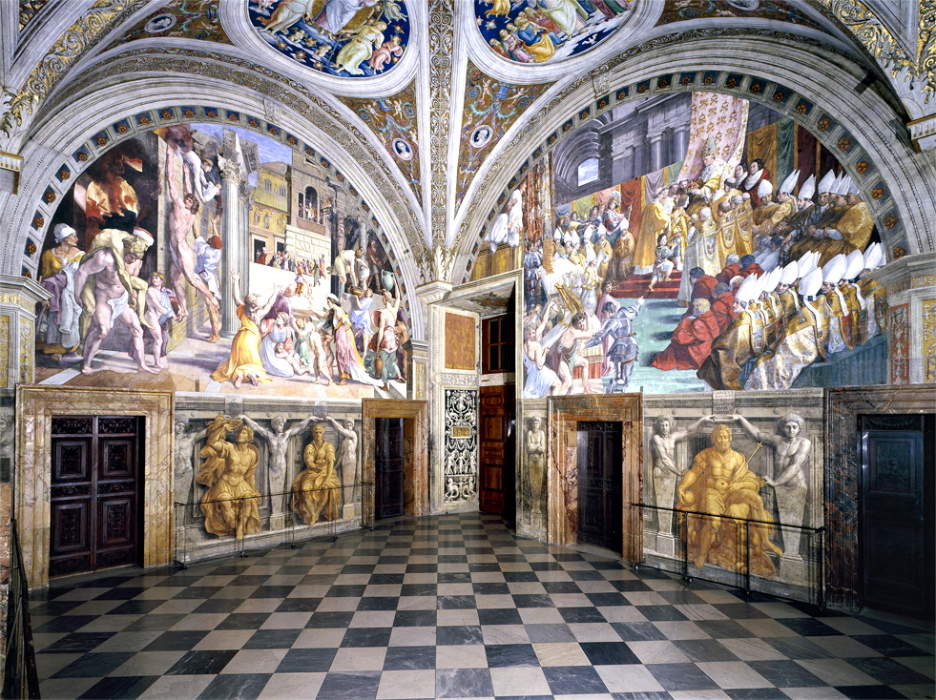 |
| The Stanza dell’Incendio di Borgo |
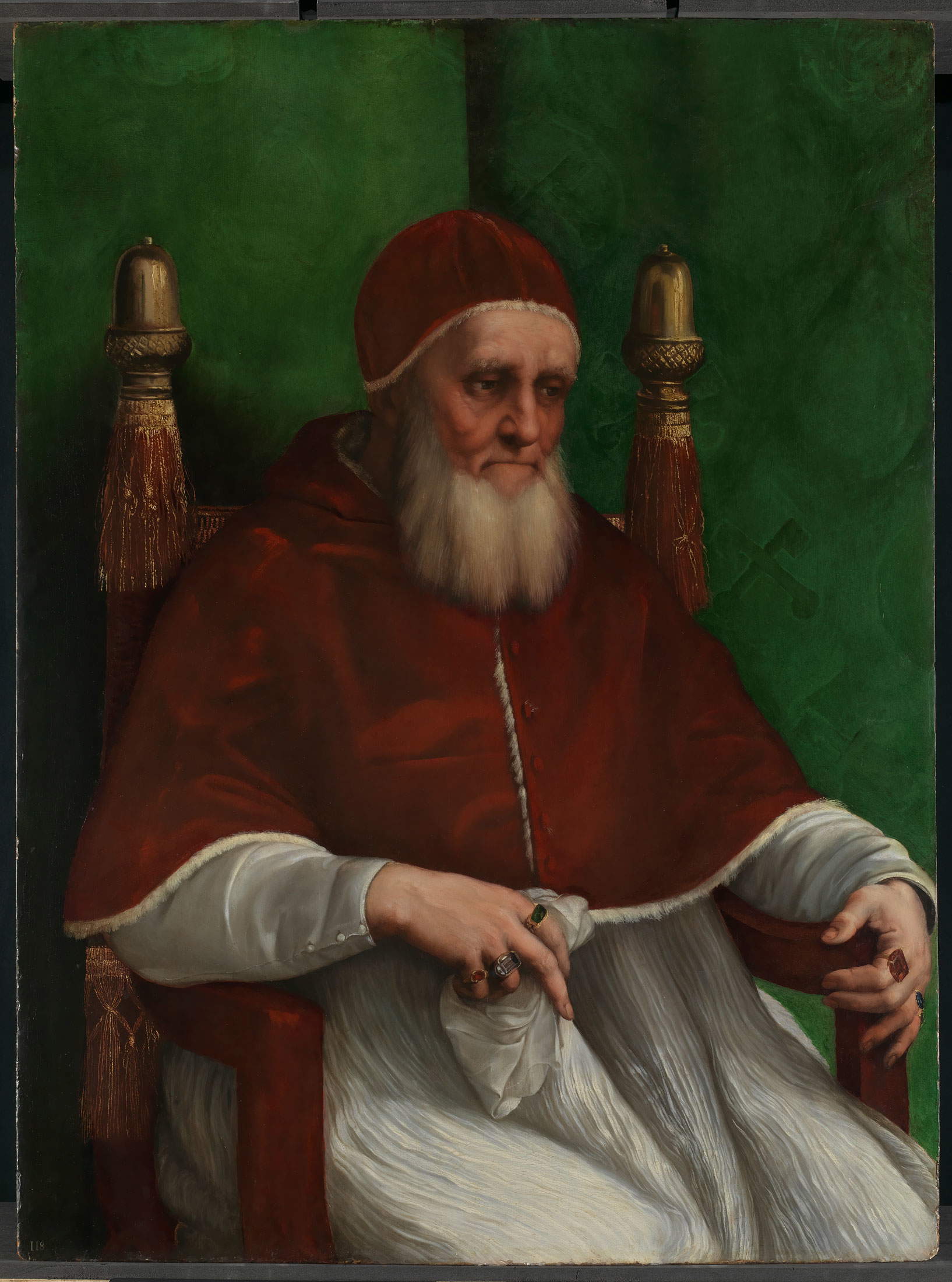 |
| Raphael, Portrait of Julius II (pre-March 1512; oil on panel; London, The National Gallery). © The National Gallery, London |
In the third room, which was later called of the Incendio di Borgo, he wanted to remove equally all the frescoes on the walls (even those he himself had asked Lotto and Perugino to do) but we have to imagine him now looking up. The belligerent pope restrained for a moment: within him roared that removente spirit that wanted to renew everything, as in the rooms next door, but up there swirled the Eternal Father, the Creator, cum angelis et arcangelis and with the heavens open, handing over to Christ, therefore to the Church the exercise of Justice and Mercy! A breath of spirituality and sacramental power rose up in his soul, and behind him perhaps he heard the ringing voice of him, his Raphael, saying “most blessed Father, let us leave this divine document above your glory; the Father in heaven will honor you forever,” and he added “my master, Perugino, well knew it when he painted here.”
The ceiling remained.
Under Perugino’s vòlta Pope Julius had stopped! And the Urbino would repay him with immortal masterpieces. Thus it remained, and remains, a Peruginesque relic in the “Raphael Rooms.” Why? We should carefully consider this beautiful aerial page, which too many visitors do not contemplate and which critics gloss over. We should do so today after that astonishing and very careful salvation operation at the end of the 20th century, which unfortunately passed into the fringe pages of the “forgotten restorations,” overwhelmed by the worldwide clamor of the similar interventions on the ceiling of the Sistine Chapel. It was passionately authored by Claudio Rossi de Gasperis, a Vatican restorer.
For a substantive analysis of the work in question, it is necessary to broaden our gaze to the first of the famous Stanze and, taking their wall subjects for granted, to see the roles of the painted ceilings. The vòlta of the Stanza della Segnatura chooses a complex, biblical-astrological and at the same time allegorical theme. The vòlta of the Room of Heliodorus turns to the strongest themes of the Old Testament, namely the historical, personal relationship of the Creator with the Patriarchs. In the vòlta of the Stanza dell’Incendio di Borgo, by the pictorial hand of Perugino, there finally appears the extraordinary and supreme theological reality of the Holy Trinity, taken from the Dispute but here fulfilled in the living figure of Jesus Christ according to the divine plan that wills ab eternally the completion of Creation with the Incarnation of the Word, for human Redemption through the Word Himself. It is the highest theme of revelation, of the purpose of earthly life, of the priestly role that Jesus conveys to the Apostles, led by Peter, throughout the unbroken theory of the ages. An intense, shining theophany, epitome of the entire biblical reality.
Faced with this assumption, no one, we believe, could certainly look for another theme, especially since the figure of the Pontiff, repeated in the events on the walls, consecrated the papal role as decisive and preponderant in history. Of this Julius was well aware, and he observed with complacency that vòlta key, in the center of the sails, which bore the coat of arms of the apostolic keys with the tiara, all surrounded by the palmettes and roveresque acorns. It was the obvious metaphor of his presence.
Perugino, too, had considered with great awareness the ideal task of this vòlta: to show the empyreans above the world and there the figures of the Divinity itself. For this reason, not unmindful of Mantegna’s and Melozzo’s émpits he broke through the real space with four openings to the heavens. We can see in the fiction we propose how this was the precise purpose. The Master Restorer points out how the current deep blue background that appears everywhere around the suspended figures is due, after restoration, to the imitation of the azurite used by the painter: we must therefore imagine a total ethereal space that opens above the physicality of the ceiling and that can be grasped through the four “skylights,” real conductors of light. In fact, the frames that illusively accompany the overcoming of the physical thickness of the ceiling are flared in a perspective sense, from bottom to top, and here we must say that the painter has grasped a specific datum of spatial conquest that was maturing in the Italian Renaissance.
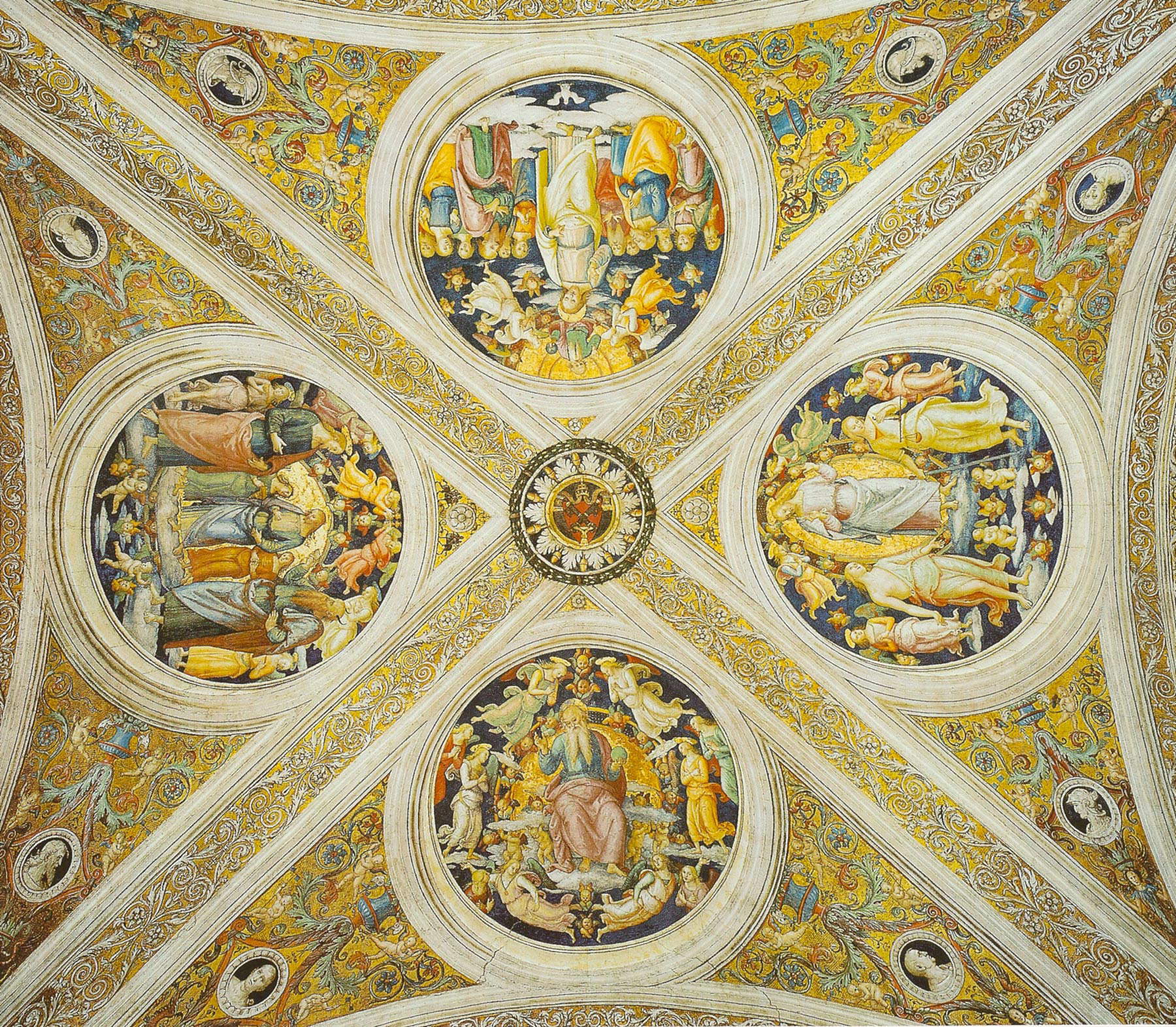 |
| The vault of the Stanza dell’Incendio di Borgo in the Vatican, painted by Perugino (1507-1508). Below the Eternal Father surrounded by Angels and Archangels. |
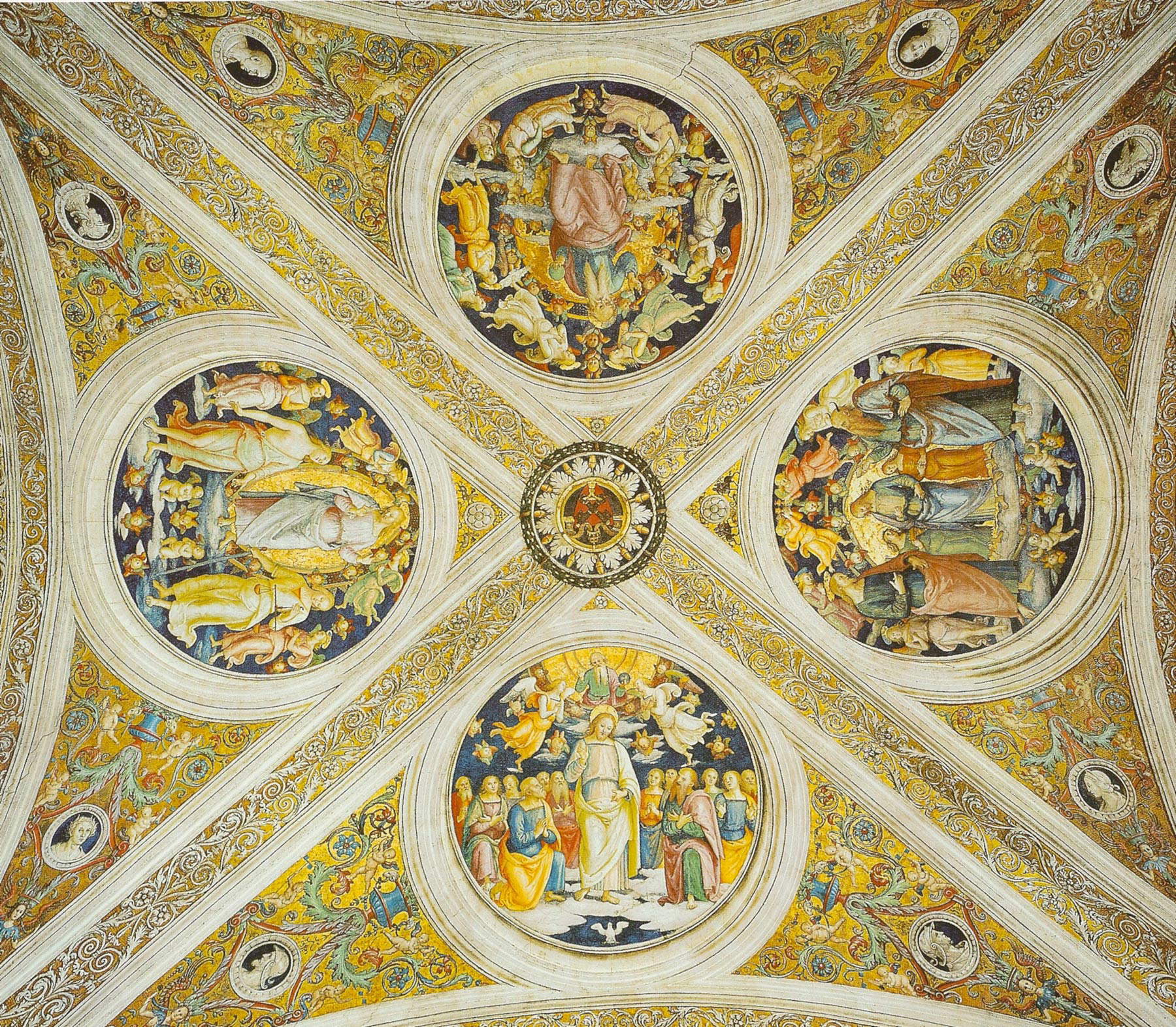 |
| The same vault. Below is the depiction of the Trinity. Here has relief the incarnation of the Word. |
 |
| The ceiling arches in four not very elevated sails. The ribs, painted in classical racemes, meet in the center in the papal coat of arms surrounded by palmettes and roveresque acorns. |
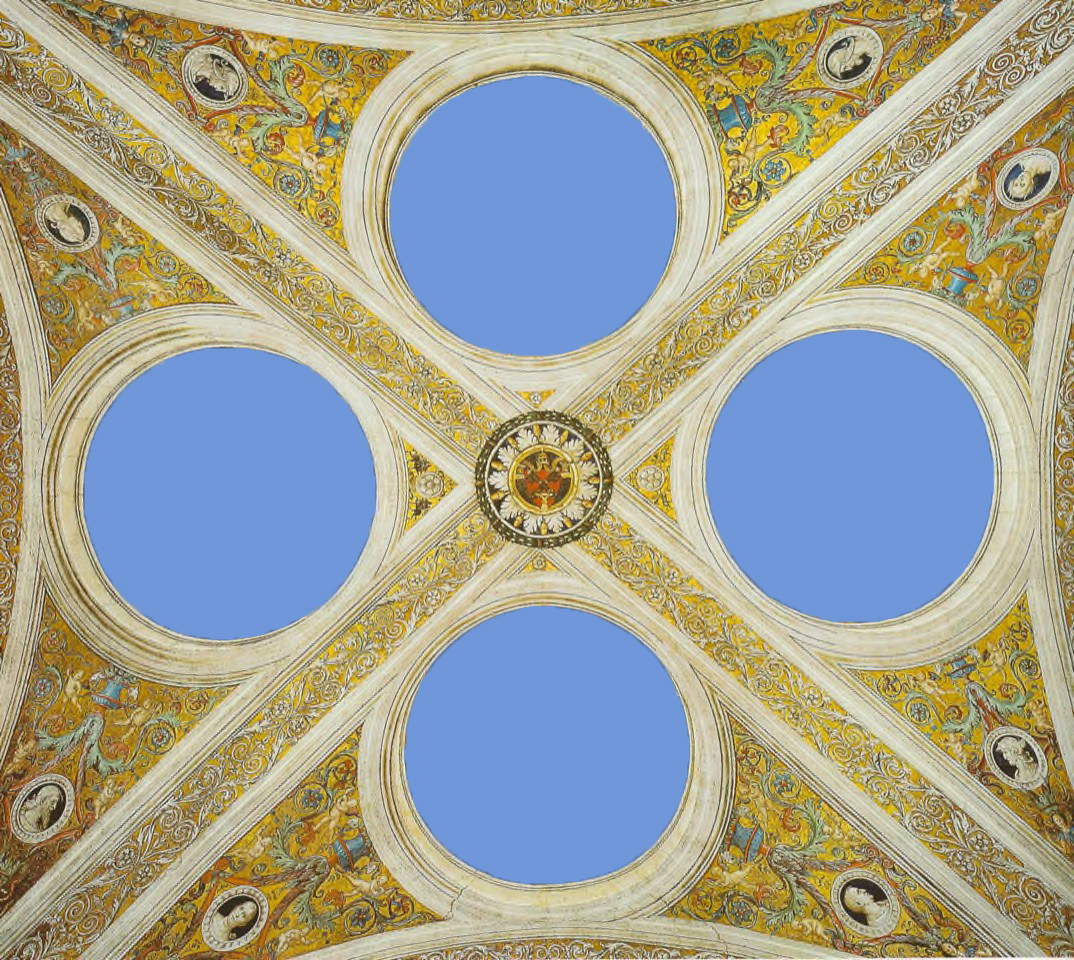 |
| Photographic fiction. It shows how Perugino wanted to pictorially perforate the ceiling toward the sky, here diurnal. The frames of the perforations are in fact perspective upward, forming “skylights.” |
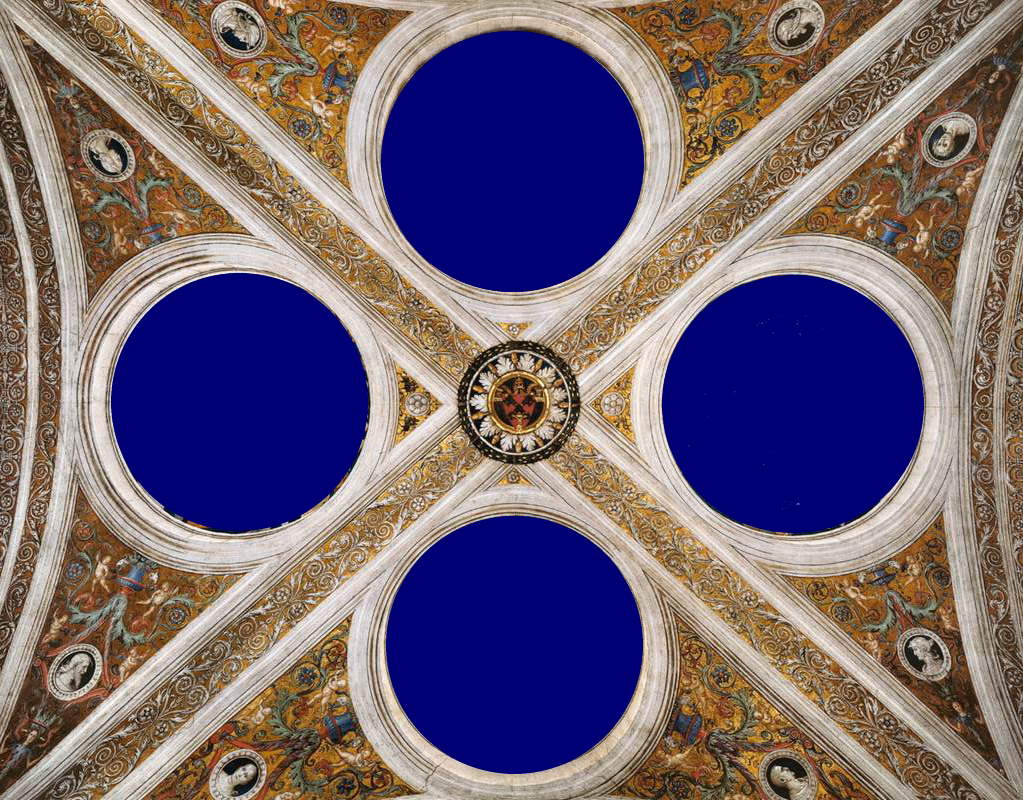 |
| The fiction reveals how each vision appears suspended in the empyrean, densely blue as befits the mystery (here is the azurite), and has then made cogent the typical colors of a stained glass window. |
Here, then, are the four parts of what is a single vision. The Eternal Father enthroned, surrounded by cherubim and angels sits within the golden circle of light: he holds the world, the symbol of the entire creation, in his hand; his angels have the colors of the theological virtues and are shown suspended in superhuman pneuma. In vertical continuation from the figure of the Father, in the mirrored oculus here is the Trinity, the very essence of God, showing above the Father in Dante’s “three rounds”; in the center Jesus incarnate, standing and glorious, surrounded by the kneeling Apostles; below Christ, toward us, hovers the Holy Spirit, in the form of a dove. Jesus, in bodily garb stands in the center of the other two circular scenes; in one (again celestial) He appears between the personification of holiness and victory over the tempter (who has devilish horns on his head), thus victor over evil; in the other, as Sol Justitiae, He triumphs (within the mandorla of divinity) suspended between Justice Himself, equipped with scales and sword, and Mercy, who stands at His right, toward whom He turns with a benign gesture and gaze. Beautiful are these two figures, typical of Perugino, which Raphael could not fail to admire. And splendid is the whole teleology(telos = the ultimate goal) that concludes the Three Rooms.
During the restoration, in the first prospecting, Rossi de Gasperis noticed a fall from the chest of Justice: it was the imprint on the negative with respect to what was supposed to be the significant pendant of the ideal character: that necklace on the chest that later turned out to be Solomon’s Knot. Thus the Vatican Claudio (he was born in Vatican City) with color recreated on the precise imprint the sign of the great King of Israel. On this sign there existed, since Mesopotamian antiquity, a very strong and complex symbolism, taken up by various peoples and reaching as far as Dante in the Divine Comedy. In short, the knot signifies the perfect equity of Justice, the indissolubility of the same in its judgments, and in the Crusader composition it recalls a very high Christian value.
All the restoration, of truly international merit, restored the beauty of the Perugian masterpiece, where some details deserve specific attention: the grotesques for example, which are “tempered” in the Christian sense and which preserve in the racemes the Ravenna splendors of the divine garden; the placing of the encomiastic cameos, with the virtuous heads of the men and women of classical antiquity; the background, which is extremely precious, enhanced diffusely by gold. And now with the extensive analysis we come to perfectly explain the Master’s choice of colors in the figured scenes: having to be placed as if on a window to the sky they choose the intensity and role of stained glass. Thus we understand that admirable feeling of “light effect” that emanates precisely from the supernal “skylights,” which mystically receive it from Heaven.
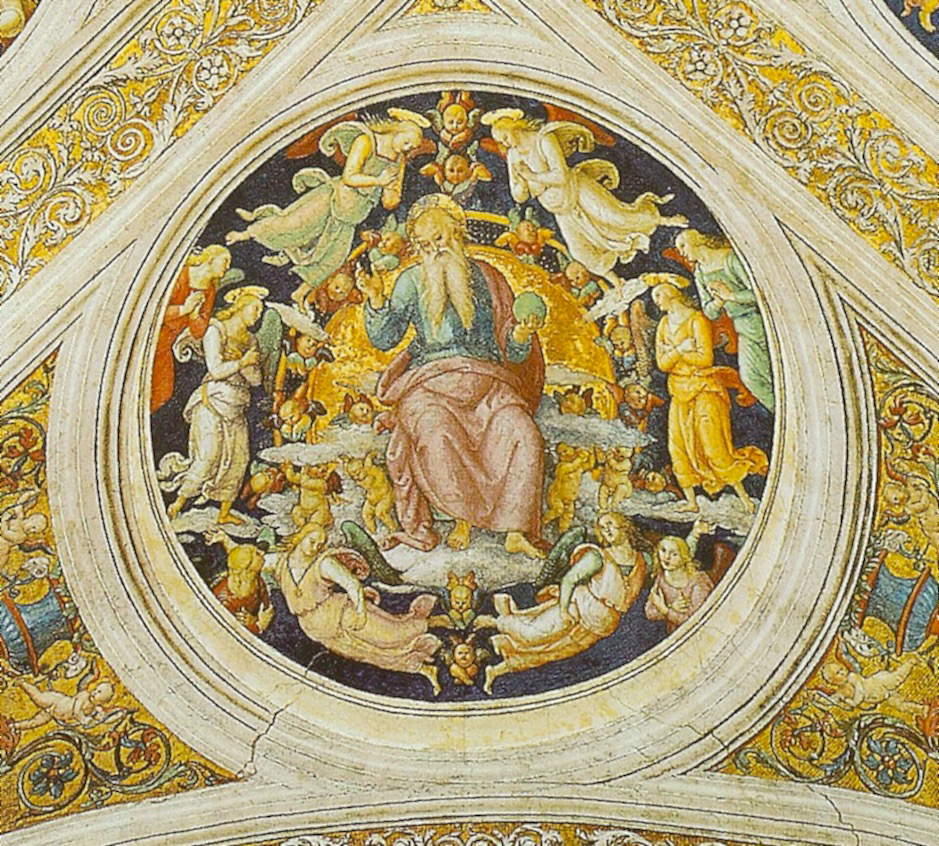 |
| The Eternal Father, in a golden throne, appears as beneficent Creator. |
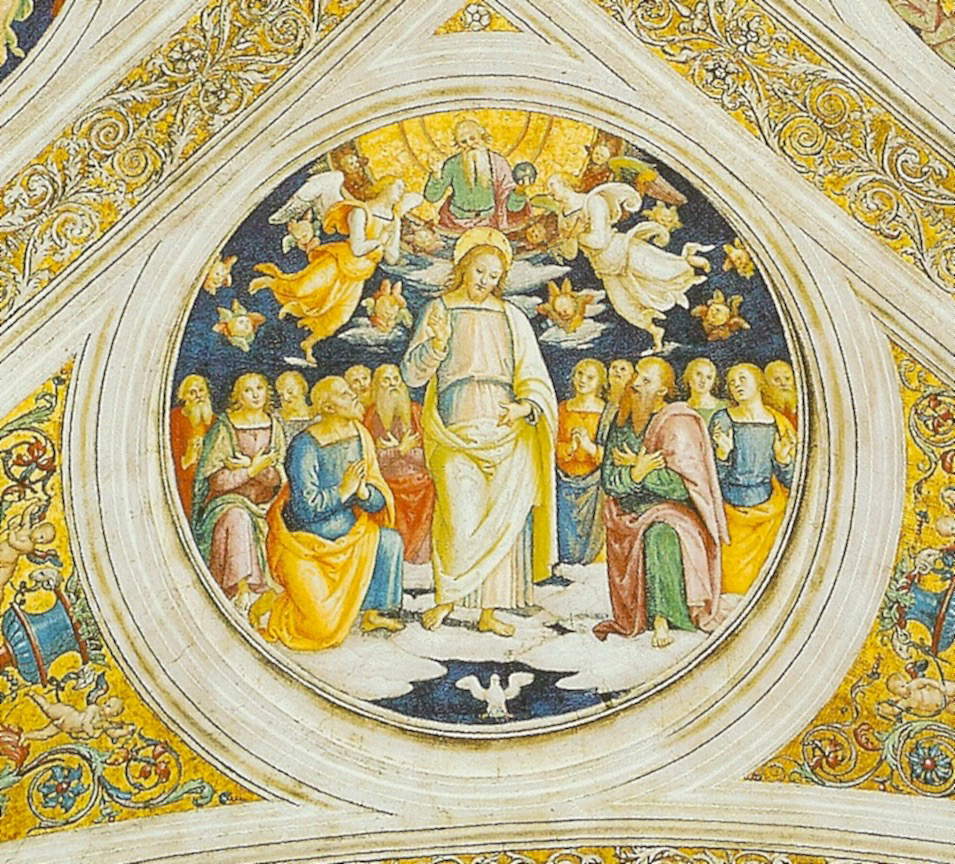 |
| The Trinity. The Father appears in Dante’s three turns. The Son is incarnated in the person of Jesus and is worshiped by the twelve apostles. The Holy Spirit in the form of a dove hovers over us. |
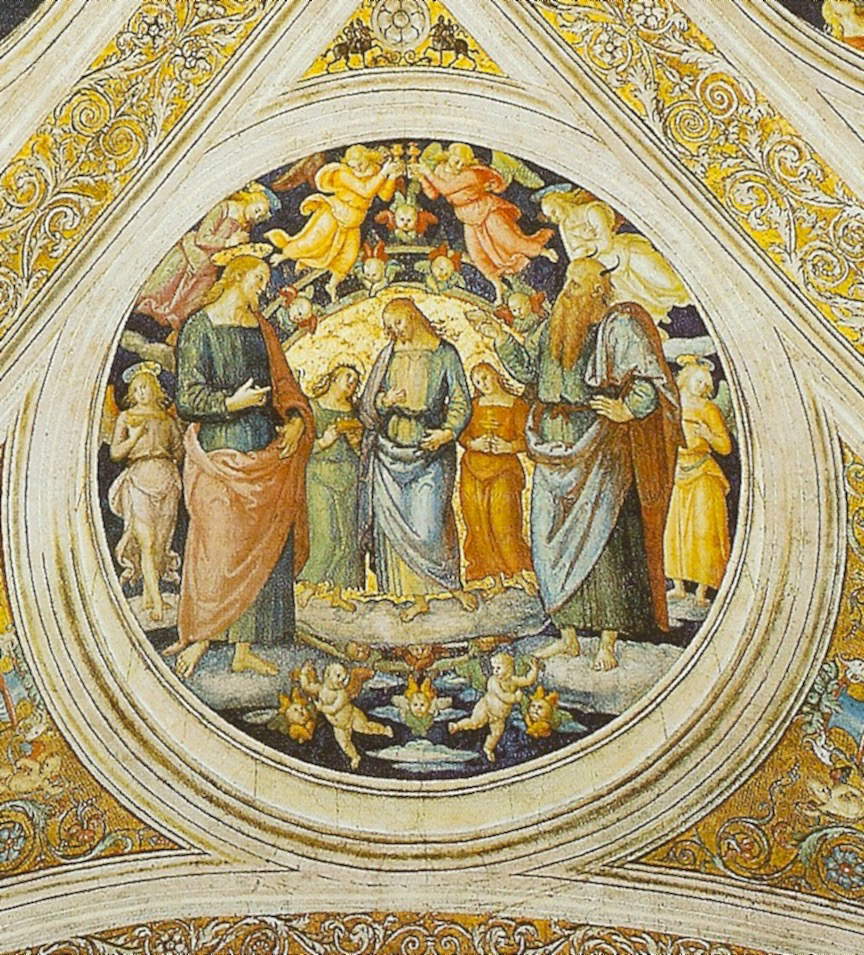 |
| Christ, appearing in the substance of his coming to earth, between the two symbolic figures of Holiness and Evil. Together they are a metaphor for the choices of our freedom. |
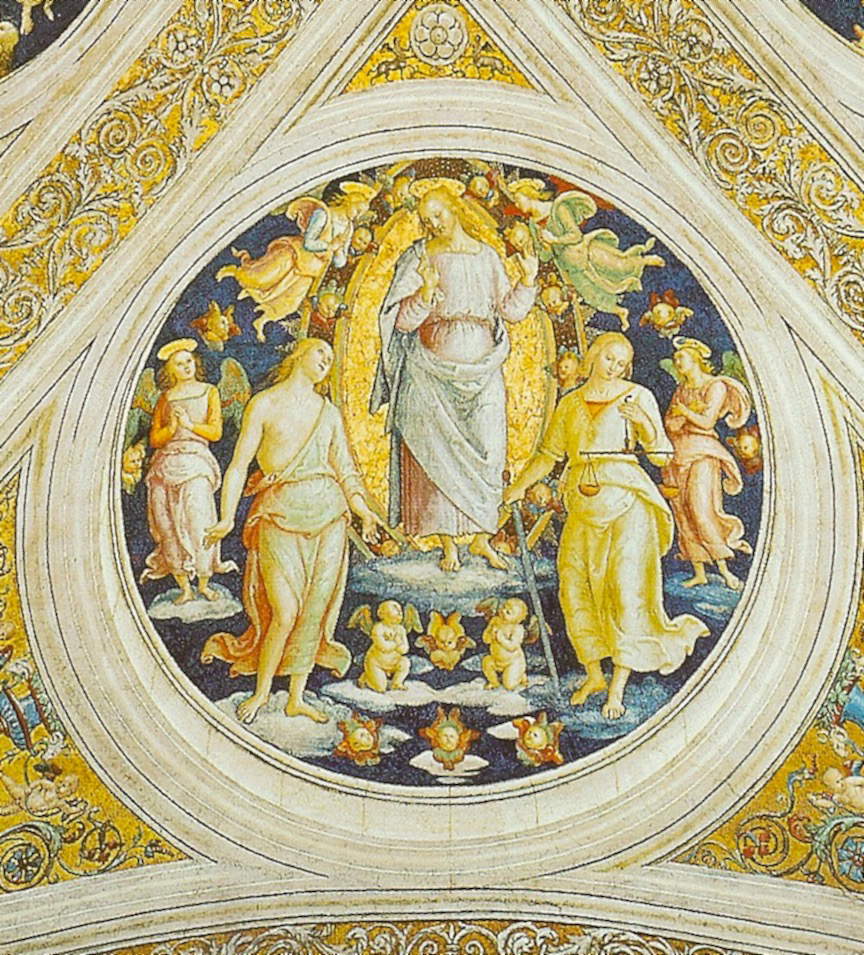 |
| Beautiful composition by the Master of Raphael. Jesus, sun of truth, stands between Justice armed with scales and sword and Mercy whom we see at his right: to it goes divine benevolence. |
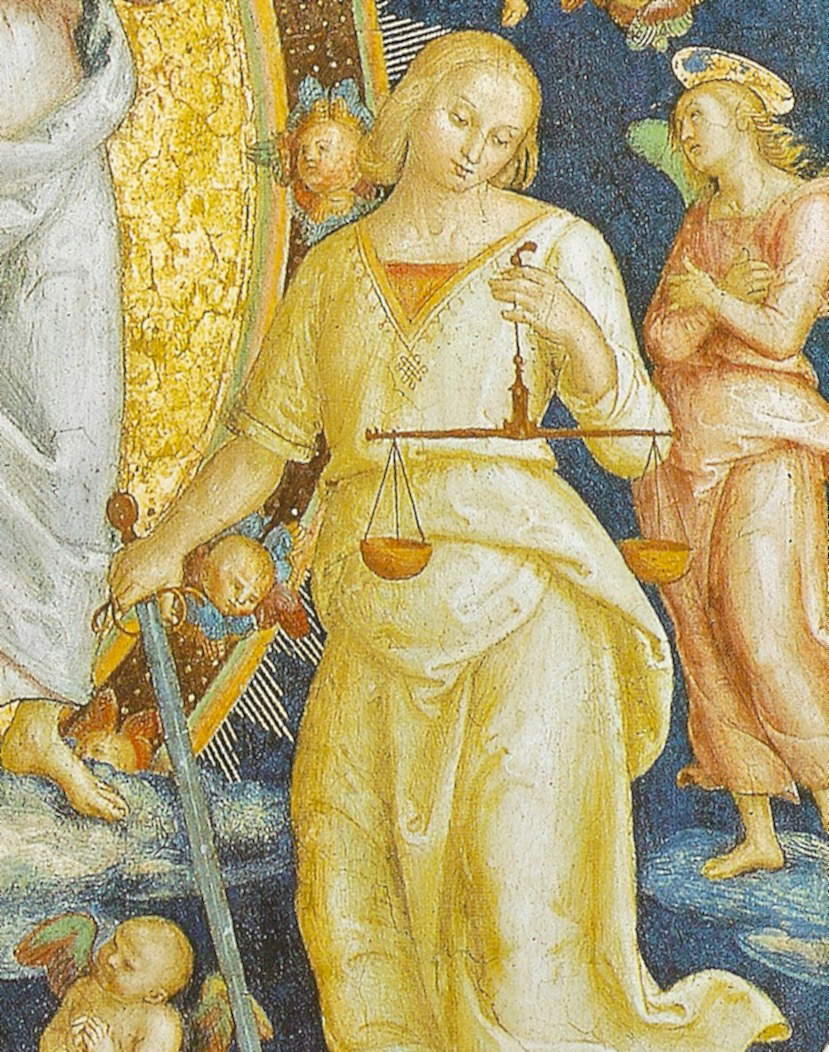 |
| The figure of Justice. Restoration has given her back the revealing pendant in the center of her chest. It is the famous knot of Solomon. |
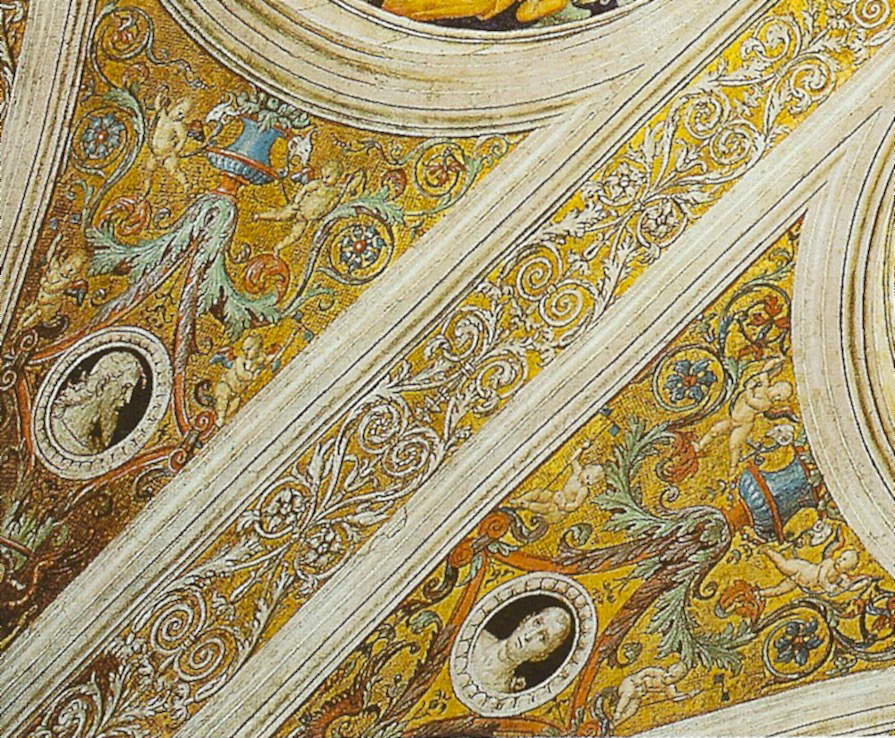 |
| The splendid and very careful decoration. |
Warning: the translation into English of the original Italian article was created using automatic tools. We undertake to review all articles, but we do not guarantee the total absence of inaccuracies in the translation due to the program. You can find the original by clicking on the ITA button. If you find any mistake,please contact us.